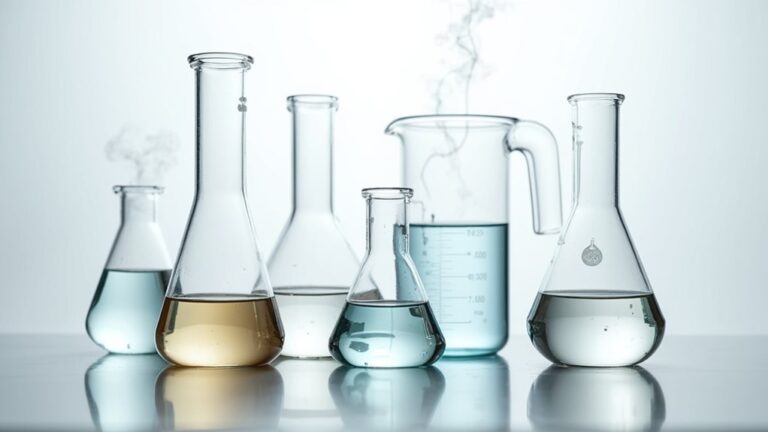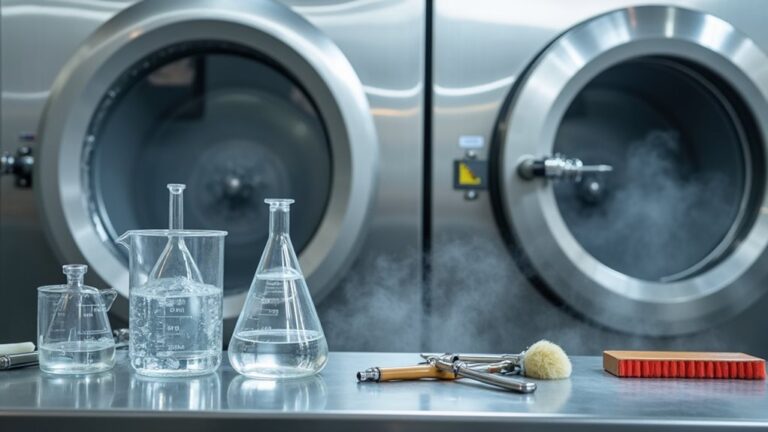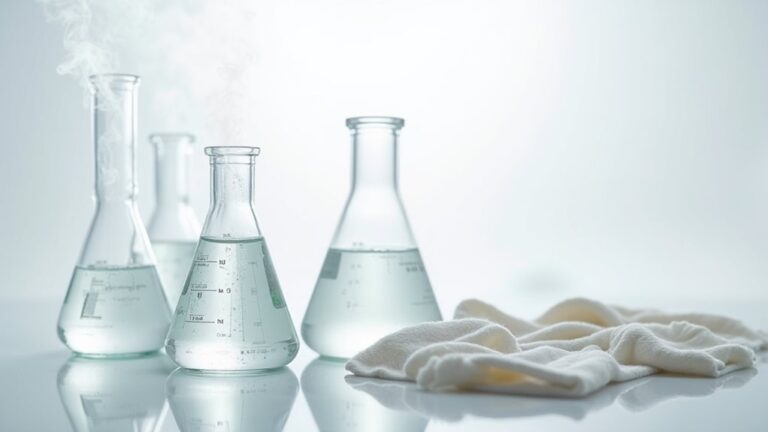Dry cleaning solvents work by using non-polar chemicals like perchloroethylene that act as molecular detectives, targeting and dissolving oil-based stains that water can’t touch. When you drop off that silk dress, the solvent breaks down greasy substances at the molecular level while mechanical agitation loosens embedded dirt from delicate fibers. Unlike water-based washing, these solvents won’t damage fragile fabrics, and sophisticated recovery systems capture 99.99% of chemicals for reuse, making the process surprisingly efficient and your garments impeccably clean through fascinating chemical interactions.
The Science Behind Solvent-Based Cleaning
When I first learned about dry cleaning chemistry, I’ll admit I was confused about how something called “dry” cleaning could actually clean anything – turns out, it’s not really dry at all!
Despite its misleading name, dry cleaning isn’t actually dry – it’s just a different kind of wet that works magic on stubborn stains.
The magic happens when your clothes take a bath in non-polar dry cleaning solvents like perchloroethylene, which work completely differently than your home washing machine.
While water-based detergents struggle with greasy stains because oil and water don’t mix (remember that science class experiment? 😅), these specialized solvents dissolve oils effortlessly.
The cleaning process involves mechanical agitation that lifts dirt without damaging delicate fabrics, and here’s the remarkable part – facilities recover 99.99% of solvents through distillation, greatly reducing environmental impact while keeping your favorite silk blouse looking pristine.
This gentle approach is why dry cleaning is the preferred method for structured garments like suits and formal wear, where maintaining shape and preventing shrinkage is crucial.
Types of Dry Cleaning Solvents and Their Properties
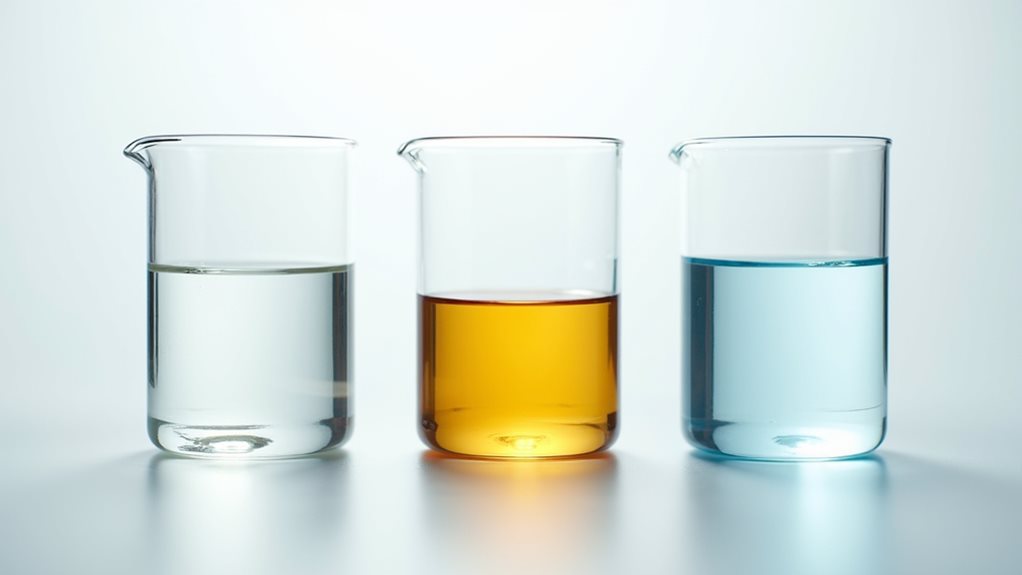
When I first started researching dry cleaning methods, I was honestly overwhelmed by the variety of solvents available, each with their own quirky benefits and concerning drawbacks that’ll make your head spin faster than a washing machine on the fritz.
You’ll find that perchloroethylene remains the heavyweight champion of the industry, dominating most professional cleaners despite growing health concerns, while hydrocarbon alternatives and eco-friendly options like siloxane are slowly gaining ground among environmentally conscious consumers who care about both their clothes and the planet.
Understanding these different solvent properties becomes essential when you’re choosing where to take your favorite silk blouse or that expensive wool coat, because trust me, not all dry cleaners are created equal! 😅
Another innovative option gaining popularity is liquid carbon dioxide, which offers excellent cleaning power while being completely non-toxic and environmentally safe.
Perchloroethylene: Industry Standard Solvent
The workhorse of the dry cleaning industry, perchloroethylene—or “perc” as it’s affectionately called by professionals—dominates roughly 70% of cleaning operations across the United States, and honestly, it’s not hard to see why.
This dry cleaning solvent cuts through grease like nobody’s business, tackling stubborn stains that would make your washing machine wave a white flag in surrender. Its thermal stability and nonflammable nature mean you can trust it with delicate silks and wool without worrying about fabric meltdowns or texture disasters.
However, perc’s cleaning performance comes with a catch—it’s classified as a potential carcinogen, which explains California’s 2023 phase-out plan.
While alternatives like synthetic petroleum exist, perc remains the gold standard for superior results. The solvent’s ability to dissolve oils and greases while maintaining chemical stability makes it particularly effective for removing oil-based stains from various fabric types.
Hydrocarbon and Alternative Options
While perc might reign supreme in the dry cleaning kingdom, smart business owners have been quietly building their empires with hydrocarbon solvents, capturing about 20% of the market with what many consider a gentler, more earth-conscious approach.
These petroleum-derived alternative solvents still fall under the volatile organic compounds umbrella, but they’re considerably kinder to fabrics and workers alike.
Here’s what you’ll find when exploring beyond traditional methods:
- Siloxane solutions pamper delicate fabrics while remaining biodegradable and fume-free.
- Liquid carbon dioxide systems offer chemical-free cleaning but struggle with stubborn stains.
- Water-based wet cleaning tackles both oil and water stains with specialized temperature control.
Don’t get fooled by vague “eco-friendly” marketing though – these terms lack standardized definitions, so you’ll need to dig deeper.
Historical solvents like Stoddard solvent and white spirits paved the way for today’s petroleum-based alternatives, though safety and environmental concerns have largely phased them out of modern operations.
Environmental and Safety Properties
Although choosing the right dry cleaning solvent might seem like someone else’s problem, understanding the environmental and safety trade-offs can save you from accidentally supporting practices that harm your community, your clothes, and frankly, your own peace of mind.
Perc dominates the industry despite being a potential carcinogen—honestly, that’s a red flag you shouldn’t ignore. Synthetic petroleum alternatives masquerade as “green” solutions while releasing environmental pollutants that contribute to ozone formation.
However, siloxane offers genuinely promising safety properties, being biodegradable and gentle on fabrics, though only 5% of cleaners use it.
Meanwhile, wet cleaning eliminates harsh chemicals entirely, proving that effective stain removal doesn’t require sacrificing environmental responsibility or risking your family’s health.
The popularity of perc stems from its superior ability to dissolve oils and grease while being non-flammable, making it an attractive choice for commercial dry cleaning operations.
How Solvents Remove Different Types of Stains
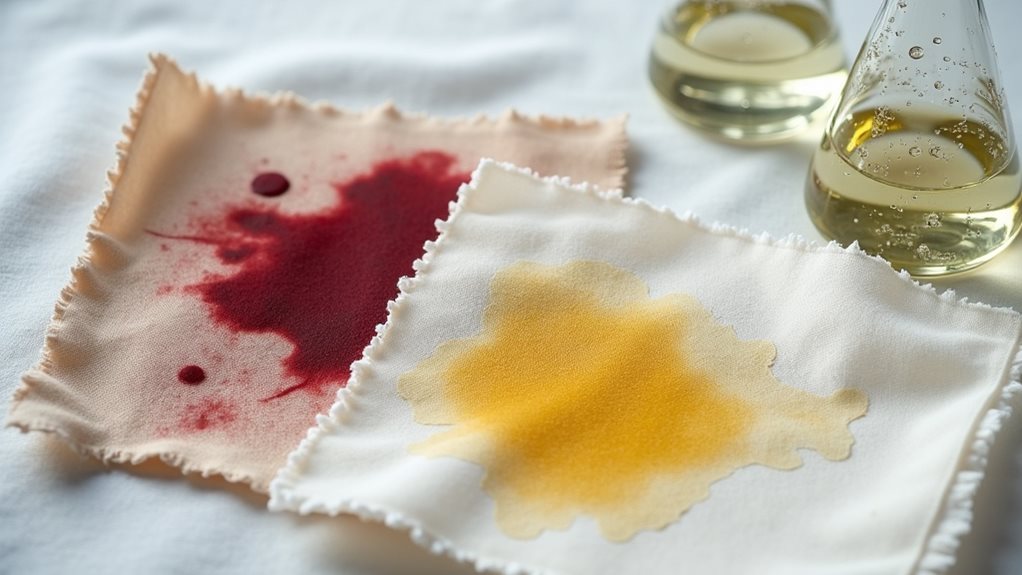
Because solvents work like molecular matchmakers, they’re incredibly selective about which stains they’ll tackle with enthusiasm, and honestly, understanding this chemistry felt like revealing a secret code when I first learned it.
Dry cleaning solvents like perchloroethylene excel at dissolving oil-based stains because they share similar non-polar properties, making them perfect dance partners that naturally attract each other.
Here’s how the cleaning process targets different stains:
- Greasy substances from automotive work or cooking get broken down at the molecular level as solvents penetrate fabric fibers.
- Water-based stains like coffee require pre-treatment since non-polar solvents can’t effectively tackle polar molecules.
- Embedded dirt gets loosened through agitation, allowing deeper penetration than traditional washing.
This selectivity protects delicate fabrics while removing stubborn stains that would survive regular laundering. Modern dry cleaning facilities often use eco-friendly alternatives to traditional solvents, which maintain the same effective stain-removal properties while reducing environmental impact.
The Cleaning Process: From Application to Recovery
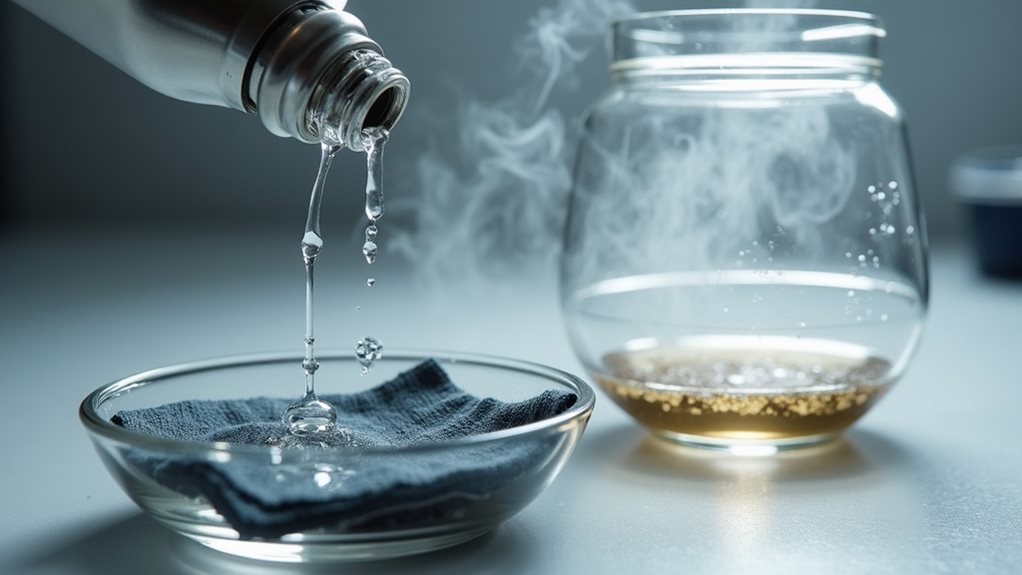
When you drop off that coffee-stained blouse at the dry cleaner, you’re witnessing the start of a fascinating three-step dance that transforms your garment from disaster to pristine perfection.
The process begins with careful solvent application methods that bathe your clothes in chemical solutions, followed by intricate stain removal mechanics that work like tiny molecular magnets pulling away stubborn spots.
Finally, sophisticated solvent recovery systems guarantee that 99.99% of those expensive cleaning chemicals get recycled back into the system, which honestly makes my environmentally-conscious heart do a little happy dance 💚.
This entire process takes place in specialized machines that resemble large washing machines but operate without water, making them perfect for delicate fabrics like silk and wool that would otherwise shrink or lose their shape.
Solvent Application Methods
The magic of dry cleaning begins the moment your favorite silk blouse or wool suit takes its first plunge into that crystal-clear solvent bath.
Honestly, watching this process for the first time reminded me of seeing a chef work with delicate ingredients—there’s something almost mesmerizing about how gentle yet thorough it all is.
The dry cleaning chemicals work through three primary application methods:
- Immersion flooding – Your garments get completely submerged in the cleaning fluid, allowing maximum penetration.
- Spray application – Targeted treatment for stubborn stains before the main wash.
- Controlled agitation – Gentle tumbling that lets the solvent reach every fiber without damaging delicate fabrics.
Each method guarantees the solvent works its magic effectively! 🧼
After the cleaning cycle completes, the distillation process purifies and recycles the used solvent, making the entire system remarkably efficient and environmentally conscious.
Stain Removal Mechanics
Once your garments slip beneath that shimmering surface of solvent, something remarkable happens that I find absolutely fascinating—the perc molecules immediately begin their microscopic dance, weaving through every fiber like tiny molecular detectives searching for oil-based culprits.
These dry cleaning solvents don’t just splash around randomly; they’re working methodically, breaking down grease molecules at their weakest bonds while mechanical agitation gently coaxes stubborn stains loose from fabric fibers.
The stain removal magic happens when oil meets its molecular match—perc dissolves what water simply can’t touch.
During this cleaning process, I’ve watched expensive silk blouses emerge spotless after being completely saturated in solvent, then rinsed with fresh perc to wash away dissolved contaminants, proving that sometimes the gentlest approach yields the most powerful results.
Following the solvent extraction phase, garments undergo a specialized drying process that removes any remaining chemical solvents while preparing them for the final pressing stage.
Solvent Recovery Systems
After witnessing countless gallons of perc seemingly vanish into thin air during my early days observing dry cleaning operations, I discovered that modern solvent recovery systems are fundamentally sophisticated recycling marvels that capture and reuse an astounding 99.99% of every precious drop.
These systems transform what could be environmental disasters into sustainable cleaning processes through three crucial stages:
- Filtration and distillation – removing impurities from extracted solvent for immediate reuse
- Warm air drying – tumbling garments at 140-145°F to evaporate remaining solvent
- Vapor capture – collecting evaporated solvent and returning it to the recovery system
You’ll find that effective solvent recovery systems don’t just minimize environmental impact—they’re brilliant engineering solutions that help dry cleaners comply with regulations while protecting workplace safety. 😊
While perchloroethylene remains the most common solvent, many facilities are transitioning to eco-friendly alternatives like liquid CO2 and silicone-based cleaners that offer similar cleaning effectiveness with reduced environmental concerns.
Fabric Compatibility and Solvent Selection

When you’re standing in your closet holding that gorgeous silk blouse you splurged on last month, the last thing you want is to watch it shrink into doll-sized proportions because someone at the dry cleaner chose the wrong solvent.
Fabric compatibility isn’t just industry jargon – it’s the difference between preserving your favorite garments and accidentally creating expensive cleaning rags. Understanding dry cleaning solvents helps you become your clothes’ best advocate.
Perchloroethylene works brilliantly on oil stains but can be aggressive on delicate fabrics, potentially causing fading or distortion. Hydrocarbon solvents offer gentler alternatives for sensitive materials like wool and silk, while newer siloxane options provide non-toxic, biodegradable cleaning that preserves fabric integrity beautifully.
Always check care labels for solvent selection guidance – they’re your roadmap to garment longevity.
Environmental and Health Considerations of Modern Solvents
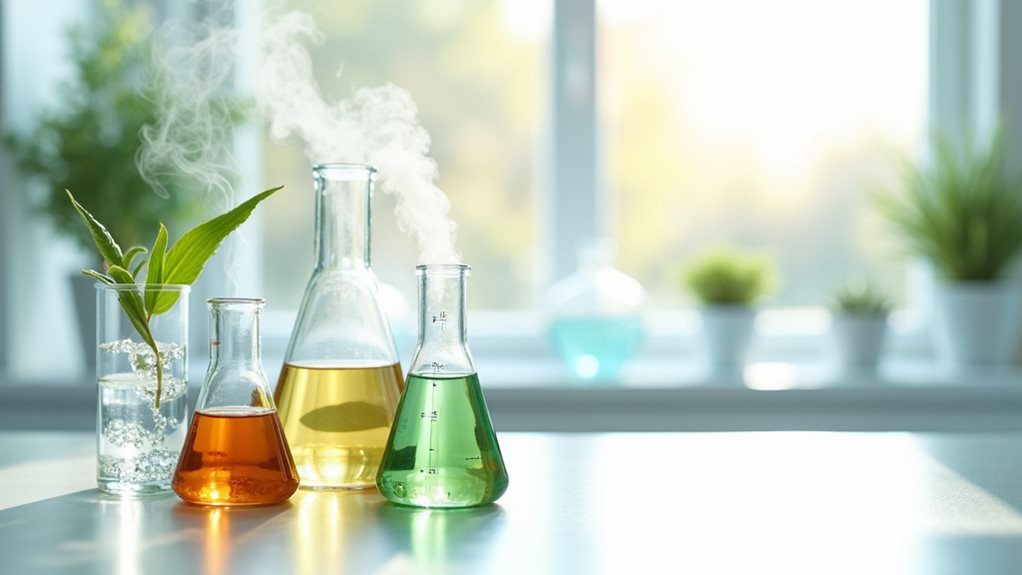
Here’s what you need to know about today’s solvent environment:
- Traditional perchloroethylene carries health risks – classified as a carcinogen, leading to EPA’s 2020 phase-out from residential facilities.
- Newer alternatives like siloxane offer safer options – these environmentally friendly solvents biodegrade naturally while staying gentle on delicate fabrics.
- Liquid carbon dioxide sounds perfect but costs more – though non-toxic, it’s expensive and sometimes struggles with stubborn stains.
I’ve learned that asking your cleaner about their solvent choices isn’t being picky—it’s being smart about protecting what matters most.


